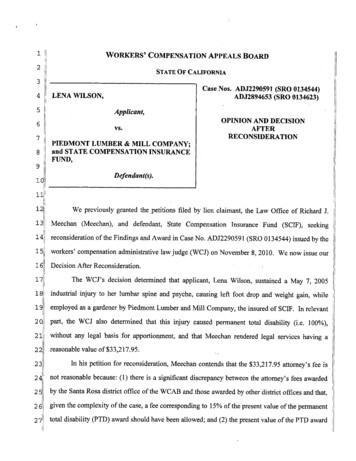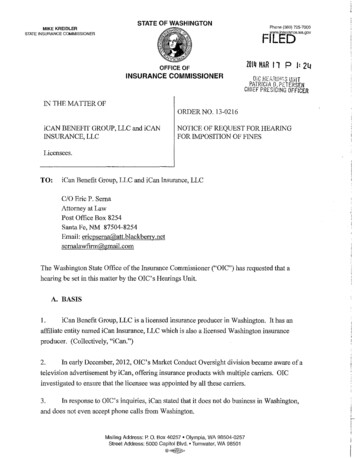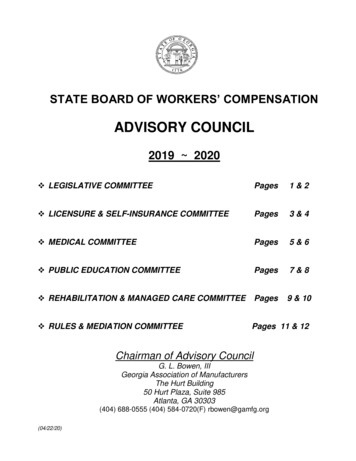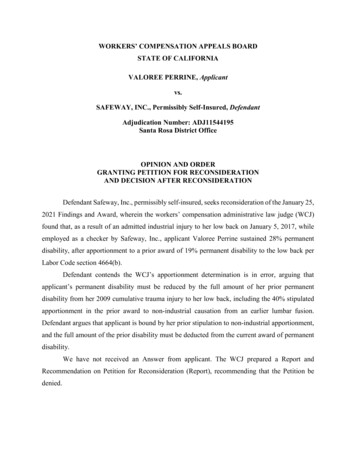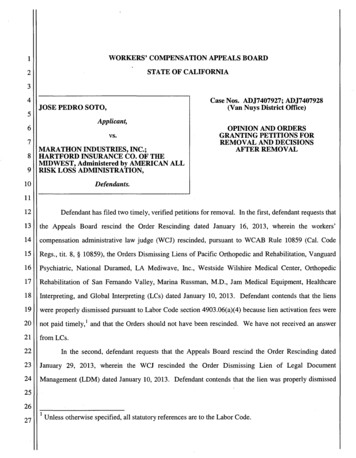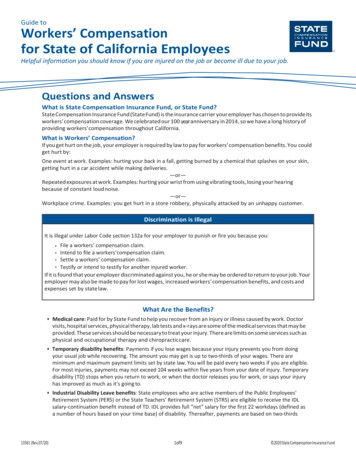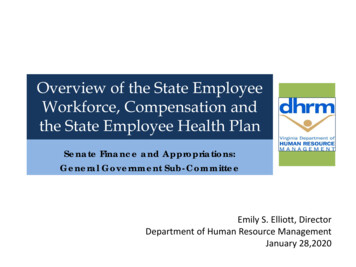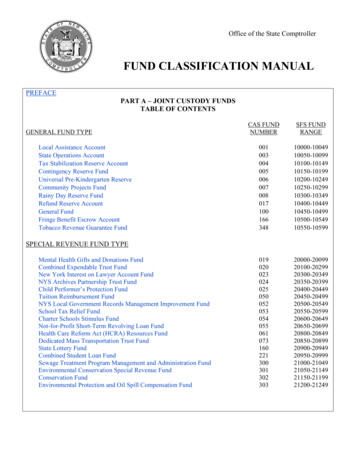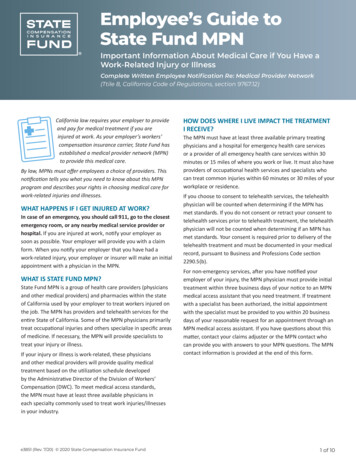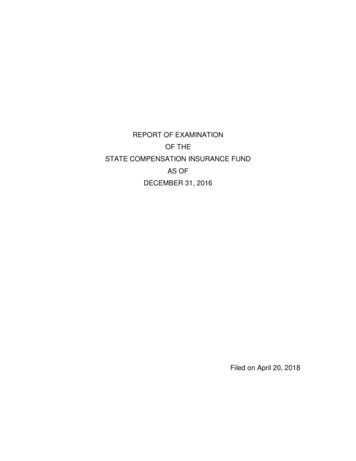
Transcription
REPORT OF EXAMINATIONOF THESTATE COMPENSATION INSURANCE FUNDAS OFDECEMBER 31, 2016Filed on April 20, 2018
TABLE OF CONTENTSPAGESCOPE OF EXAMINATION . 1STATE FUND HISTORY . 2MANAGEMENT AND CONTROL:. 3Management Agreement . 5TERRITORY AND PLAN OF OPERATION . 5REINSURANCE: . 6Assumed . 6Ceded . 6Loss Portfolio Transfer . 7FINANCIAL STATEMENTS: . 9Statement of Financial Condition as of December 31, 2016 . 10Underwriting and Investment Exhibit for the Year Ended December 31, 2016 . 11Reconciliation of Surplus as Regards Policyholders from December 31, 2012through December 31, 2016 . 12COMMENTS ON FINANCIAL STATEMENT ITEMS: . 13Losses and Loss Adjustment Expenses . 13Borrowed Money . 13SUBSEQUENT EVENTS . 13SUMMARY OF COMMENTS AND RECOMMENDATIONS: . 14Current Report of Examination . 14Previous Report of Examination . 14ACKNOWLEDGMENT . 15
San Francisco, CaliforniaMarch 20, 2018Honorable Dave JonesInsurance CommissionerCalifornia Department of InsuranceSacramento, CaliforniaDear Commissioner:Pursuant to your instructions, an examination was made of theSTATE COMPENSATON INSURANCE FUND(hereinafter referred to as State Fund) at its regional office located at 1010 VaqueroCircle, Vacaville, California 95688. State Fund’s home office is located at 333 BushStreet, 8th Floor, San Francisco, California 94104.SCOPE OF EXAMINATIONWe have performed our single-state examination of State Fund. The previousexamination of State Fund was made as of December 31, 2012. This examination coversthe period from January 1, 2013 through December 31, 2016.The examination was conducted in accordance with the National Association of InsuranceCommissioners Financial Condition Examiners Handbook (Handbook). The Handbookrequires the planning and performance of the examination to evaluate State Fund’sfinancial condition, assess corporate governance, identify current and prospective risks,and evaluate system controls and procedures used to mitigate those risks.Anexamination also includes identifying and evaluating significant risks that could cause aninsurer’s surplus to be materially misstated both currently and prospectively.
All accounts and activities of State Fund were considered in accordance with the riskfocused examination process. This includes assessing significant estimates made bymanagement and evaluating management’s compliance with Statutory AccountingPrinciples. The examination does not attest to the fair presentation of the financialstatements included herein. If, during the course of the examination, an adjustment isidentified, the impact of such adjustment will be documented separately following StateFund’s financial statements.This examination report includes findings of fact and general information about StateFund and its financial condition. There may be other items identified during theexamination that, due to their nature (e.g., subjective conclusions, proprietary information,etc.), were not included within the examination report but separately communicated toState Fund.STATE FUND HISTORYState Fund is a public enterprise fund whose organization and powers are defined byCalifornia Insurance Code (CIC) Sections 11770 through 11805. Concurrently with theenactment of the first compulsory workers’ compensation laws in California, State Fundwas established by the California Legislature in 1914 to provide an available market forworkers’ compensation insurance to employers located in California.Effective January 1, 2013, Senate Bill (SB) 1513 was approved by the Governor onSeptember 30, 2012 and was enacted into law under California Insurance Code (CIC)Section 11797. SB 1513 allows State Fund, until January 1, 2025, to invest or reinvest anaggregated maximum of twenty percent of moneys in excess of the admitted assets overthe liabilities and required reserves in the investments allowed pursuant to CIC Sections1191, 1192.4, 1192.6, 1192.10, 1194.7, and 1198. It also requires the CaliforniaDepartment of Insurance to submit to the Legislature by January 31, 2019, a report thatassesses the benefit and risk of State Fund’s equities investment history by measuring2
the volatility and total return of State Fund’s investment portfolio with and without equities.The report is to be submitted pursuant to Government Code Section 9795.MANAGEMENT AND CONTROLPursuant to California Insurance Code Section 11770, the Board of Directors of StateFund is composed of eleven appointed, voting members and one ex-officio, nonvotingmember. Nine of the board members (including the chairperson) are appointed by theGovernor, of which one appointed member must be from organized labor. One memberis appointed by the Speaker of the Assembly and also must represent organized labor.The eleventh member is appointed by the Senate Committee on Rules and must havebeen a policyholder of State Fund, or an officer or employee of a policyholder, for oneyear immediately preceding the appointment, and must continue in this status during theperiod of his or her membership. The Director of Industrial Relations is a non-voting exofficio member of the Board, and is not counted for quorum or any other purposes. Allboard members, other than the Director of Industrial Relations, serves for a period of fiveyears until the appointment and qualification of their successors.Following are the directors and principal officers of State Fund serving atDecember 31, 2016:Board of DirectorsName and LocationPrincipal Business AffiliationChristine BakerBerkeley, CaliforniaDirectorDepartment of Industrial RelationsRobin L. BakerBerkeley, CaliforniaEmeritaUniversity of California, BerkeleySheryl A. Chalupa, ChairBakersfield, CaliforniaPresident and Chief Executive OfficerGoodwill Industries of South Central CaliforniaDaniel M. CurtinCarmichael, CaliforniaDirectorCalifornia Conference of Carpenters3
Board of Directors (continued)Name and LocationPrincipal Business AffiliationMarvin P. KropkeBrea, CaliforniaBusiness ManagerInternational Brotherhood of Electrical Workers(IBEW) Local Union 11Senator Michael J. MachadoLinden, CaliforniaRetiredLawrence E. MulryanSan Rafael, CaliforniaRetiredJack L. NeureuterGeyserville, CaliforniaRetiredSteven L. RankRoseville, CaliforniaExecutive DirectorSafety & Health Ironworkers International(International Association of Bridge,Structural, Ornamental and Reinforcing IronWorkers)Thomas E. RankinBerkeley, CaliforniaVice PresidentCalifornia Alliance for Retired AmericansScott K. ReidPlacerville, CaliforniaDirectorEconomic and Statistical Research BureauFranchise Tax BoardWilliam M. ZachrySan Carlos, CaliforniaSenior FellowSedgwick InstitutePrincipal OfficersNamePositionVernon L. SteinerPeter A. GuastamachioPresident and Chief Executive OfficerChief Financial Officer and Chief InvestmentOfficerChief Risk OfficerChief Operating OfficerChief Information OfficerKenneth R. Van LaarRichard J. LawMarjorie Hutchings4
Principal Officers (Continued)NamePositionMargie LariviereStephen P. HuncklerDante RobinsonAndreas AckerGeneral CounselChief Claims Operations OfficerChief of Internal AffairsExecutive Vice President and ChiefAdministrative OfficerExecutive Vice President of Public AffairsExecutive Vice President of Enterprise ProjectManagementJennifer VargenDarlyn ReganManagement AgreementState Fund has a master agreement with the California Department of Human Resourcesto adjust workers’ compensation claims and process the payments related to stateemployees’ injuries. State Fund pays compensation benefits to the injured workers andmedical benefits to the health providers. The state agencies reimburse State Fund forcompensation and medical benefits paid, plus the cost of adjusting. State Fund billsannual service fees for processing these claims on a full cost recovery basis. State Fundrecords a receivable for these reimbursements under “Due from adjusting contracts.” Allstate agencies make deposits in a trust account that is held by State Fund for future billsand are reported under “Amounts held in trust liability.”TERRITORY AND PLAN OF OPERATIONState Fund is authorized only to transact workers’ compensation insurance business,including liability under the United States Longshoremen’s and Harbor Workers’Compensation Act in the State of California. It is a quasi-government entity organized toinsure California businesses that are unable to obtain coverage from private insurers. Itsoperations are funded from collections of policy premiums and returns from investments,and most of its employees are civil service employees. State Fund’s liabilities are not5
guaranteed by the State of California; however, the benefits to injured workers insured byState Fund are backed by the California Insurance Guaranty Association.Business is written on a direct basis and through its broker distribution channel. StateFund’s home office is located in San Francisco, California and has regional offices locatedthroughout California. The day-to-day operations and majority of its employees arelocated in Pleasanton and Vacaville, California. As of December 31, 2016, State Fundreported 1.6 billion in total direct premiums written and is the largest workers’compensation insurer in California with a market share of 12.4%.REINSURANCEAssumedState Fund assumes a small amount of workers’ compensation insurance businesswritten by Zurich America Insurance Company covering the employees located outsideof California that are employed by State Fund’s policyholders pursuant to CaliforniaInsurance Code Section 11780.5(2).During 2016, reinsurance assumed was only 251,000.CededThe following is a summary of the principal reinsurance agreements in-force as ofDecember 31, 2016:Type ofContractLine(s) ofBusinessReinsurer(s) and ParticipationState Fund’sRetentionReinsurer’s LimitsUnauthorizedGolden State Re II Ltd 100 millionultimate net losseach triggerevent 250 million excessof 100 millionultimate net losseach trigger eventAll Perils (excluding usiness6
Type ofContractLine(s) ofBusinessReinsurer(s) and ParticipationState Fund’sRetentionReinsurer’s LimitsMulti-YearWorkers’CompensationExcess of BusinessAuthorizedMunich Reinsurance America, Inc(50.00%) 350 millionultimate net losseach lossoccurrence 50 million excess of 350 million ultimatenet loss each lossoccurrence, subjectto a limit of 100million for all lossoccurrences duringeach contract BusinessAuthorizedArch Reinsurance Company (16.00%)Lloyd’s of London (19.70%)Various reinsurers (34.02%) 400 millionultimate net losseach lossoccurrence 250 million excessof 400 millionultimate net losseach lossoccurrence, subjectto a limit of 500million for all lossoccurrences duringthe contract term 100 millionultimate net losseach lossoccurrence 235 million excessof 100 millionultimate net losseach lossoccurrence 235 million termlimitWorkers’CompensationExcess of LossUnauthorizedMunchener Ruckversicherungs AG(50.00%)UnauthorizedEverest Reinsurance (Bermuda) Ltd(10.00%)Various reinsurers (20.28%)Terrorism (including nuclear, biological, chemical or radiological)TerrorismExcess ityBusinessAuthorizedArch Reinsurance Company (11.00%)Lloyd’s of London (44.99%)Various reinsurers (29.61%)UnauthorizedVarious reinsurers (14.40%)*State Fund is covered under the Federal Terrorism Risk Insurance Program Reauthorization Act (TRIPRA) up to 393 million in excess of 324 million ultimate net loss. TRIPRA covers 84% and State Fund retains 16% of the ultimatenet loss.Loss Portfolio TransferIn August 2002, State Fund entered into a Loss Portfolio Transfer (LPT) with XL Re Ltd.(XL Re) and ACE Bermuda Insurance Ltd (ACE). Effective January 1, 2007, XL Reassumed all the rights and obligations of ACE under the LPT through an AssumptionReinsurance and Novation Agreement. The LPT covers workers’ compensation lossespaid after January 1, 2002 on accident years 1980 to 1998. Loss adjustment expenses,employers’ liability and United States Longshoremen’s and Harbor Workers’Compensation Act losses are excluded. Under the LPT agreement, State Fund retainsan amount of aggregate subject losses and the reinsurers are liable for 90% share of7
losses in the covered layers. The maximum amount recoverable under the reinsuredlayers of the agreement is 90% of 1.45 billion. The following table is a summary of thereinsured layers of coverage:Coverage LayersState Fund’s RetentionReinsurer’s LimitsFirst Layer 950 million of aggregate subject losses90% of 1.15 billion excessof 950 million aggregatesubject lossesSecond Layer 200 million of aggregate subject losses90% of 300 million excessof 2.1 billion aggregatesubject lossesAs of December 31, 2016, cumulative subject paid losses of 2.2 billion exceeded theupper limit of the first layer of 2.1 billion placed at 90%. After the 950,000,000 StateFund’s retention, total billed losses were 1.035 billion of which 899.7 million werecollected from the reinsurers.8
FINANCIAL STATEMENTSThe following financial statements are based on the statutory financial statements filed byState Fund with the California Department of Insurance for the period endingDecember 31, 2016. The accompanying comments to the amounts reported in thefinancial statements should be considered an integral part of the financial statements. Noadjustments were made to the financial statements as a result of the examination.Statement of Financial Condition as of December 31, 2016Underwriting and Investment Exhibit for the Year Ended December 31, 2016Reconciliation of Surplus as Regards Policyholders from December 31, 2012through December 31, 20169
Statement of Financial Conditionas of December 31, 2016AssetsLedger andNonledgerAssetsAssets NotAdmittedNet AdmittedAssetsNotesBonds 18,904,435,531 18,904,435,531Common stocks895,418,312895,418,312Real estate:Properties occupied by the company244,319,436244,319,436Properties held for sale710,488710,488Cash, cash equivalents and short-term investments224,084,442224,084,442Receivables for securities35,37235,372Investment income due & accrued133,539,091133,539,091Uncollected premiums and agents’ balances incourse of collection176,023,10285,420,25090,602,852Deferred premiums, agents’ balances and installmentsbooked but deferred and not yet due151,253,70815,125,379136,128,329Amount recoverable from reinsurers2,238,8082,238,808Funds held by or deposited with reinsured companies600,000600,000Guaranty funds receivable or on deposit30,898,3251,224,13829,674,187Electronic data processing equipment and software10,066,975593,5629,473,413Furniture and equipment6,890,6726,890,672Aggregate write-ins for other than invested assets67,351,7917,607,84859,743,943Total assets 20,847,866,053 116,861,849 20,731,004,204Liabilities, Surplus and Other FundsLossesLoss adjustment expensesCommissions payable, contingent commissions and othersimilar chargesOther expenses (excluding taxes, licenses and fees)Taxes, licenses and fees (excluding federal and foreign income taxes)Borrowed moneyUnearned premiumsAdvance premiumPolicyholders dividends declared and unpaidCeded reinsurance premiums payableAmounts withheld or retained by company for account of othersRemittances and items not allocatedProvision for reinsurancePayable for securitiesAggregate write-ins for liabilities Total liabilities14,035,948,355Aggregate write-ins for special surplus fundsUnassigned funds (surplus) 1,560,374,5935,134,681,256Surplus as regards policyholders6,695,055,849Total liabilities, surplus and other funds 20,731,004,20410(1)(1)(2)
Underwriting and Investment Exhibitfor the Year Ended December 31, 2016Statement of IncomeUnderwriting IncomePremiums earned 1,527,223,571Deductions:Losses incurredLoss adjustment expenses incurredOther underwriting expenses incurred 1,130,211,278493,467,528381,871,225Total underwriting deductions2,005,550,031Net underwriting loss(478,326,460)Investment IncomeNet investment income earnedNet realized capital gains 626,850,28269,268,684Net investment gain696,118,966Other IncomeNet loss from agents’ or premium balances charged offAggregate write-ins for miscellaneous income (31,457,842)542,532Total other loss(30,915,310)Net income before dividends to policyholders, after capital gains taxesand before federal and foreign income taxesDividends to policyholders186,877,196(4,690,564)Net income 191,567,760Capital and Surplus AccountSurplus as regards policyholders, December 31, 2015 6,539,438,983Net incomeChange in net unrealized capital gainChange in nonadmitted assetsChange in provision for reinsuranceAggregate write-ins for losses in surplus Change in surplus as regards policyholders for the 4,143,998)155,616,866Surplus as regards policyholders, December 31, 2016 6,695,055,84911
Reconciliation of Surplus as Regards Policyholdersfrom December 31, 2012 through December 31, 2016Surplus as regards policyholders, December 31, 2012,per Examination 6,011,868,861Gain inSurplusNet incomeChange in net unrealized capital gainsChange in nonadmitted assetsChange in provision for reinsuranceAggregate write-ins losses in surplus 778,493,926132,427,125Total gains and losses 910,921,051Loss inSurplus 35,519,2065,917,875186,296,982Net increase in surplus as regards policyholders 227,734,063683,186,988Surplus as regards policyholders, December 31, 2016,per Examination 6,695,055,84912
COMMENTS ON FINANCIAL STATEMENT ITEMS(1) Losses and Loss Adjustment ExpensesA Casualty Actuary from the California Department of Insurance (CDI) evaluated theUnpaid Liability Adequacy Test and Experience Report as of December 31, 2016prepared by State Fund’s independent actuary and concurred that State Fund’s lossesand loss adjustment expense reserves as of December 31, 2016 were reasonable andhave been accepted for purposes of this examination.(2) Borrowed MoneyEffective February 15, 2012, State Fund entered into an Advances and SecurityAgreement with the Federal Home Loan Bank (FHLB) of San F
Dec 31, 2016 · State Fund is a public enterprise fund whose organization and powers are defined by California Insurance Code (CIC) Sections 11770 through 11805. Concurrently with the enactment of the first compulsory workers’ compensation laws in California, State Fund was established by the Californ
